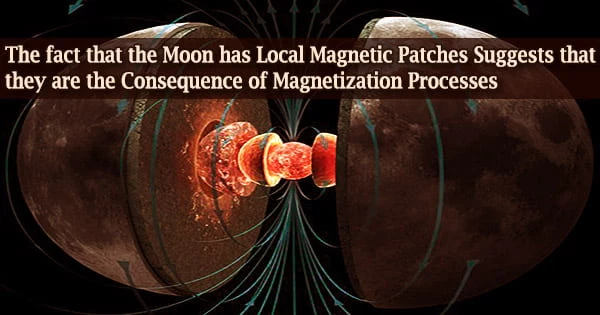The moon currently lacks an internal magnetic field, which may be sensed on Earth. However, there are small areas on its surface, up to a few hundred kilometers in diameter, where a very strong magnetic field exists.
Measurements on rocks from the Apollo missions have proven this. The origin of these magnetic patches has remained a mystery since then. They could be remains of an ancient core magnetic field, according to one idea.
Perhaps something like what can still be seen on Earth now. The earth’s magnetic field is generated by the rotation of the core, which is made up of liquid and solid iron. The reason why the Moon’s inner field vanished at some point is still a mystery.
Another long-held idea about the moon’s local magnetic patches claims that they are the consequence of magnetization processes produced by huge bodies colliding with the moon’s surface.
According to a new study published in the journal Science Advances, the Moon must have formerly had an internal core dynamo. The researchers arrived at their results by using complicated computer simulations to disprove the second idea.
How exactly the magnetic spots were formed still requires more research. But now it is clear that at some point in time an internal magnetic field of the Moon had to be present for this to happen.
Yuri Shprits
It is the result of large international cooperation between MIT, GFZ-Potsdam, UCLA, the University of Potsdam, the University of Michigan, and the Australian Curtin University.
The second hypothesis was bolstered by the discovery of massive and powerful magnetic patches on the other side of the moon, just opposite major lunar craters.
Their origin was assumed to be as follows: Because the Moon, unlike the Earth, lacks an atmosphere to protect it from meteorites and asteroids, such big bodies can pulverize and ionize material on its surface with full force. The Moon is surrounded by a cloud of charged particles, also known as plasma, which compresses the magnetic solar wind in space and so intensifies its magnetic field.
At the same time, the moon’s magnetic field is induced by the solar wind. All of these fields are increased at the surface opposite the impact, resulting in the observable magnetism in the crustal rock.
The researchers have now modelled the impact, including plasma production, plasma propagation around the moon, and the path of the field induced in the moon’s interior, using examples of certain well-known Moon craters like the one we recognize as its “right eye.” They simulated a variety of impact scenarios using software that was originally designed for space physics and space weather purposes.
The scientists were able to demonstrate that the amplification of magnetic fields caused by collisions and ejected material alone was insufficient to generate the large field strengths that had been estimated and measured on the moon: the resulting magnetic field is a thousand times weaker than required to explain the observations. This isn’t to say that these impacts don’t exist; they just aren’t as strong as they could be.
The simulations revealed that the magnetic field inside the moon loses a lot of its energy due to turbulence in the mantle and crust, and that field amplification by the plasma cloud on the backside of the impact is more likely to occur above the crust.
“How exactly the magnetic spots were formed still requires more research. But now it is clear that at some point in time an internal magnetic field of the Moon had to be present for this to happen,” says Yuri Shprits, Professor at the University of Potsdam and head of the Magnetospheric Physics Section at GFZ-Potsdam.
“In addition, this study can help us to better understand the nature of the dynamo-generated magnetic field and the dynamo process on Earth, the outer planets and exoplanets.”





